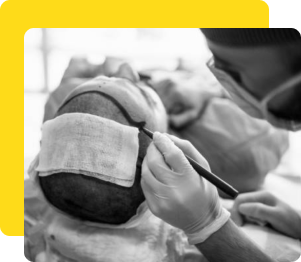FUE Hair Transplant
Hair loss can be a frustrating and distressing experience for many people. While there are several hair restoration options available, FUE hair transplant is one of the most popular and effective treatments.
Procedure: FUE Hair Transplant
Duration: 4 – 8 hours
Length of Stay in Hospital : Same day treatment
Cost in Turkey: €1600 – €2450
Anesthesia: Local anesthesia
Success Rate: 90% – 95%
Final Results: After 9 months – 12 months
Scars: No
Pain: Slight
What is an FUE Hair Transplant?
FUE stands for Follicular Unit Extraction, and it involves harvesting individual hair follicles from the scalp and transplanting them to the desired area.
Unlike the traditional FUT (Follicular Unit Transplantation) procedure, which involves removing a strip of skin from the donor area, FUE Hair transplant treatment does not require any incisions or stitches, making it a less invasive and more precise method.
This technique results in a more natural-looking and permanent solution to hair loss.

Advantages of FUE Hair Transplants
Here are the advantages of Hair transplant treatment:
- Natural-looking results: FUE hair transplant is a highly advanced technique that results in natural-looking hair growth, without the need for a linear scar.
- Less invasive: Compared to traditional hair transplant methods, such as FUT, FUE is less invasive and results in minimal scarring.
- Faster healing time: The healing time is relatively short, with most patients returning to their normal routine within a few days to a week.
- No stitches required: Since FUE hair transplant does not involve the removal of a strip of skin, there is no need for stitches, which can reduce the risk of complications.
FUE Hair Transplant Side Effects
If you are considering an FUE hair transplant, it’s important to be aware of potential side effects that can occur.
While the hair transplant treatment is generally a safe and effective procedure, like any medical procedure, there are some risks to be aware of.
- Swelling in the forehead or around the eyes
- Pain or discomfort in the donor and recipient areas
- Itching
- Bleeding
- Infection
- Scarring
- Poor results
How To Prepare for FUE Hair Transplant
Preparing for an FUE hair transplant is an important part of ensuring the success of the procedure.
Here are some steps to take before your FUE hair transplant:
Choose a Reputable Clinic
Choose a reputable clinic that specializes in FUE hair transplants. Look for reviews, patient experiences, and before and after pictures to help you make an informed decision. If you are planning to have the procedure done abroad, consider clinics in countries known for their expertise in FUE hair transplant, such as Turkey.
- Consultation
Schedule a consultation with the clinic to discuss your goals and expectations for the procedure. This is also an opportunity to discuss any medical conditions or medications you are taking that may affect the procedure. The doctor may also discuss the FUE hair transplant timeline and the expected fue hair transplant recovery timeline.
- Follow Pre-Procedure Instructions:
Follow any pre-procedure instructions provided by the clinic, such as avoiding alcohol and smoking, avoiding blood-thinning medications, and not cutting your hair too short before the procedure.
- Choose the Type of FUE Hair Transplant
Discuss with your doctor which type of FUE hair transplant you want. Some clinics offer sapphire FUE hair transplant, which uses sapphire blades for more precise incisions. Others may offer micro FUE hair transplant, which uses smaller punches for less visible scarring. You may talk to the doctor about fue hair transplant vs fut so you choose the best procedure.
- Take Time Off Work
Plan to take a few days off work to allow for a smoother recovery. The recovery timeline can vary, but most patients are able to return to work within a week.
By following these steps and taking the necessary precautions, you can ensure a smoother FUE hair transplant experience with optimal results.
How is FUE Hair Transplant Procedure Work?
Step1. Arrival at the Clinic: On the day of the procedure, you’ll arrive at the clinic and be greeted by the medical staff. You’ll be taken to a pre-operative room where you’ll be given a gown to change into. The surgical team will then review the procedure with you, answer any questions you may have, and provide you with medications to help you relax during the procedure.
Step2. Donor Area Preparation: Before the procedure begins, the surgeon will prepare the donor area (usually the back of the head) by trimming the hair short. If you’ve opted for a micro FUE hair transplant, the surgeon will use a special device to extract individual hair follicles from the donor area.
Step3. Hair Follicle Extraction: Using a special instrument, the surgeon will extract individual hair follicles from the donor area. Each follicle is carefully removed and prepared for transplantation.
Step4. Recipient Area Preparation: Once the hair follicles have been extracted, the surgeon will prepare the recipient area (where the hair will be transplanted). This involves making tiny incisions in the scalp where the hair follicles will be placed.
Step5. Hair Follicle Implantation: Using a special implantation tool, the surgeon will carefully place each hair follicle into the recipient area. This process can take several hours depending on the number of hair follicles being transplanted.
Step6. Post-Procedure Care: Once the hair follicles have been transplanted, the surgeon will provide you with detailed instructions on how to care for your scalp in the coming days and weeks. This will include information on how to avoid fue hair transplant side effects and how to promote proper healing. You’ll also be given instructions on how to care for your newly transplanted hair and what to expect in terms of fue hair transplant results and timeline.
Overall, the FUE hair transplant procedure can take several hours to complete, depending on the number of hair follicles being transplanted.
However, the results can be life-changing, especially if you’ve been dealing with hair loss for a long time. So, if you’re considering the procedure, be sure to consult with a qualified surgeon and take the time to prepare properly. The treatment consultant will also take you through fue hair transplant vs dhi so you choose the right hair transplant treatment
What To Expect During Recovery and Results
After your Treatment, you can expect some minor side effects that typically subside within a week or two.
In terms of results, you may notice some immediate improvement in the appearance of your hairline after the transplant. However, it can take several months for the full results to become apparent, as the transplanted hair needs time to grow.
Compared to other hair transplant methods like FUT, FUE typically has a shorter recovery time and less noticeable scarring. Additionally, FUE can provide a more natural-looking result since individual hair follicles are transplanted rather than a strip of hair.
FUE Hair Transplant Cost and Financing
FUE hair transplant cost varies depending on several factors, including the number of grafts required, the surgeon’s experience, and the location of the clinic.
In general, FUE hair transplant is more expensive than traditional hair transplant methods, such as FUT. The cost can range from €1600 – €2450 or more, depending on the above factors.
However, some clinics offer financing options to help make the procedure more affordable for patients.
Combining FUE Hair Transplants with Other Treatments
In addition to FUE hair transplant, there are several other treatments that can be combined to enhance the results. These include:
- PRP therapy
PRP (Platelet-rich plasma) therapy involves injecting a patient’s own platelet-rich plasma into the scalp to stimulate hair growth. This can be combined with FUE hair transplant to improve the results and promote healthy hair growth.
- Hair loss medications
There are several medications, such as finasteride and minoxidil, that can be used to prevent further hair loss and promote hair growth. These can be used in conjunction with FUE hair transplant to maintain the results.
- Scalp micro pigmentation
Scalp micro pigmentation is a non-surgical treatment that involves tattooing the scalp with small dots to create the illusion of a fuller head of hair. This can be combined with FUE hair transplant to enhance the overall appearance.
Tips for Maintaining a Healthy Scalp Post-Transplant
Some tips for maintaining a healthy scalp post-transplant include:
- Avoiding excessive sun exposure
- Using gentle shampoos and conditioners
- Avoiding harsh chemicals and styling products
- Eating a healthy and balanced diet
- Taking any prescribed medications or supplements
By following these tips, patients can ensure that their transplanted hair remains healthy and strong.
If you are considering fue hair transplant as a solution for your hair loss, it is important to consult with an experienced hair transplant specialist to determine if you are a good candidate. Contact us today to schedule a consultation and learn more about FUE hair transplant and other hair restoration options.
Frequently Asked Questions (FAQs)
Yes, FUE hair transplant can be used to treat extensive hair loss. However, the number of grafts required may be higher, and multiple sessions may be needed to achieve the desired results.
The duration of FUE hair transplant can vary depending on the number of grafts required. In general, the procedure can take anywhere from 4 to 8 hours.
FUE hair transplant has a most patients experiencing natural-looking and long-lasting results.
Yes, FUE hair transplant is a permanent solution to hair loss. The transplanted hairs will continue to grow naturally for a lifetime.
FUE and FUT are both effective hair transplant methods, but FUE is generally considered less invasive and results in less scarring.
In most cases, the donor area is shaved before FUE hair transplant to make it easier to extract the hair follicles. However, the recipient area does not need to be shaved.
